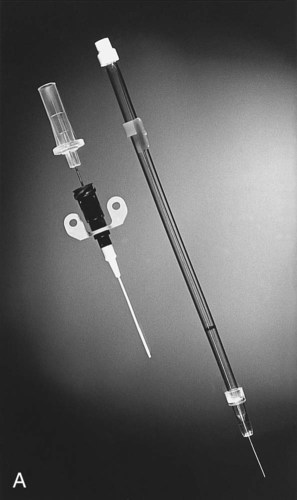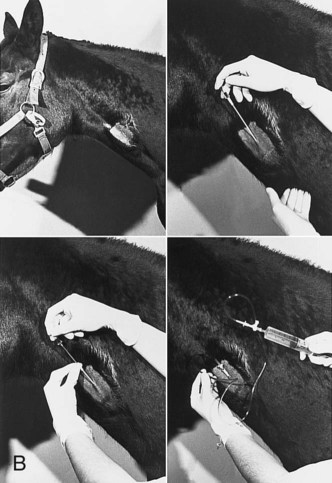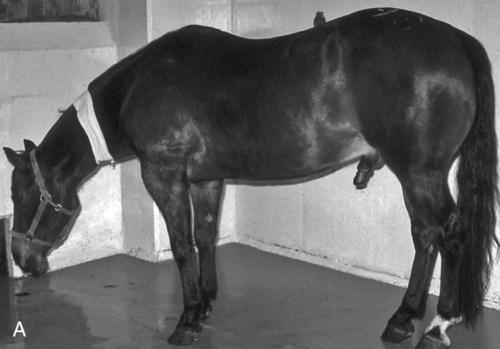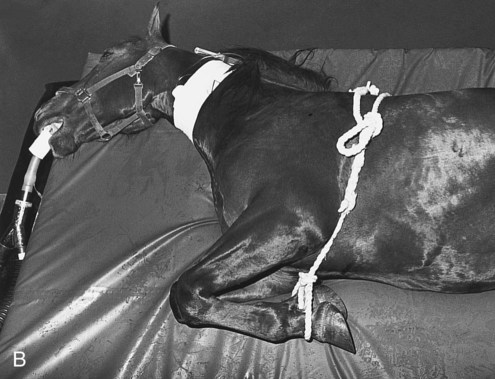I Preparing the horse for surgery A Withhold food for approximately 4 to 8 hours before surgery except in foals B Perform a complete physical examination with emphasis on cardiorespiratory function C Determine body weight using a scale or a girth weight estimator tape D Groom the horse and wipe with a moist cloth to remove dander and debris E Clean the feet before induction; pull or pad shoes to prevent injury F Prepare (clip and scrub) the surgical site before induction (if possible) to reduce anesthesia time G Place and secure an IV catheter in a jugular vein before induction (Fig. 22-1 A, and B) H Administer preanesthetic medications (antibiotics, analgesic drugs) 5 to 30 minutes before induction II Proper positioning and appropriate padding of the head, shoulder, and hip minimize the incidence of neuropathies and myopathies III All spontaneously breathing horses develop an acid-base disturbance under anesthesia, particularly respiratory acidosis (increased PaCO2) or hypoxemia (PaO2 < 60 mm Hg) when breathing air IV Controlled positive pressure ventilation can be used to maintain normal PaCO2 and may help to maintain arterial blood oxygenation (PaO2) V Prevent hypotension and hypoxemia to help avoid perioperative complications, including myopathy VI Horses should be closely monitored during the recovery period and, if needed, assisted to a standing position II Conduct a physical examination A Determine age, weight, sex, body type, physical condition B Temperament of the horse and concurrent disease (see Chapter 2) C Emphasize evaluation of the cardiopulmonary system; check for subclinical respiratory disease 1. Place a large plastic bag over the nostrils and allow the horse to rebreathe exhaled air while auscultating the horse’s lung sounds D Determine the degree of lameness or ataxia if present E Review the current and previous drug history F Consider the consequences (e.g., tissue trauma, pain, blood loss, duration) of the surgical procedure to be performed III Conduct a laboratory evaluation I Xylazine (used to produce sedation, analgesia, and muscle relaxation) A Dose: 0.4 to 1.0 mg/kg of body weight IV, 1 to 2 mg/kg intramuscularly (IM) B Onset of action: within 2 to 3 minutes after IV administration and within 10 to 15 minutes after IM administration C Duration: 30 minutes after IV administration and 60 minutes after IM administration D Sinus bradycardia and first- and second-degree atrioventricular block may occur E Head-down posture with significant ataxia and muscle relaxation F Horses are arousable and may overreact to sudden movement or sounds (startle response) II Detomidine (similar to xylazine) A Dose: 10 to 20 µg/kg IV; 20 to 40 µg/kg IM; 60 µg/kg buccally B Approximately two times longer duration of action than xylazine C Smaller volume of drug required (compared to xylazine or romifidine) D Onset of effect about 30 to 45 minutes after sublingual administration E Head-down posture with significant ataxia and muscle relaxation F Horses are arousable, and occasional disinhibition (aggression) is reported III Dexmedetomidine (similar to xylazine) IV Romifidine (similar to xylazine) A Dose: 90 to 120 µg/kg IV; 80 to 120 µg/kg IM B Reduced ataxia and head drop compared with xylazine and a longer duration of effect V Acepromazine (used to produce a calming effect) A Dose: 20 to 80 µg/kg IM; 10 to 40 µg/kg IV B Onset of action: within 10 to 20 minutes after IV administration D Decreases in arterial blood pressure may last for 12 hours E Potential for persistent penile paralysis F Mild to moderate ataxia, no analgesia but may potentiate the analgesic effects of analgesic drugs (opioids, α2-agonists) VI Chloral hydrate (infrequently used to produce or enhance sedation); 20 to 80 mg/kg IV (see Chapter 8)
Anesthetic Procedures and Techniques in Horses
Overview
General Considerations
Preanesthetic Evaluation
Preanesthetic Medications (Fig. 22-2, A)
![]()
Stay updated, free articles. Join our Telegram channel

Full access? Get Clinical Tree


Anesthetic Procedures and Techniques in Horses




